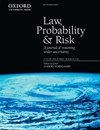Fractionalization, Polarization and Banking Stability in Africa
IF 2.7
4区 社会学
Q1 LAW
引用次数: 1
Abstract
I examine the impact of diversity (ethnic and religious fractionalization and polarization) on banking stability in Sub-Saharan Africa (SSA). Using data from 1996 to 2014, I employ the system Generalized Method of Moments (sys-GMM) approach to examine this relationship. I find that countries in SSA are more polarized religiously than they are ethnically. The region is, however, more ethnically fractionalized than they are religiously. Further, I conjecture that banks in more heterogeneous societies will experience poor asset quality and lower stability. I however postulate that banks offset the risks from diversity at certain levels of net interest margin (NIM). I provide empirical evidence to support these conjectures. I find varying threshold NIM values for each diversity indicator depending on the stability measure used. Opening up the banking system to foreign entry can help offset the negative impact of diversity on banking stability. Policy implications are discussed.分化、两极分化与非洲银行业稳定
我研究了多样性(种族和宗教的分化和两极分化)对撒哈拉以南非洲(SSA)银行业稳定性的影响。使用1996年至2014年的数据,我采用系统广义矩量法(sys-GMM)方法来检验这种关系。我发现SSA的国家在宗教上比种族上更两极化。然而,该地区的种族分化程度高于宗教分化程度。此外,我推测,在更多元化的社会中,银行将经历较差的资产质量和较低的稳定性。然而,我假设银行在一定水平的净息差(NIM)上抵消多样性带来的风险。我提供了经验证据来支持这些猜想。根据所使用的稳定性度量,我发现每个多样性指标的阈值NIM值是不同的。向外资开放银行体系有助于抵消多元化对银行业稳定性的负面影响。讨论了政策影响。
本文章由计算机程序翻译,如有差异,请以英文原文为准。
求助全文
约1分钟内获得全文
求助全文
来源期刊

Law Probability & Risk
MATHEMATICSSTATISTICS & PROBABILITY&-STATISTICS & PROBABILITY
CiteScore
2.10
自引率
28.60%
发文量
8
期刊介绍:
Law, Probability & Risk is a fully refereed journal which publishes papers dealing with topics on the interface of law and probabilistic reasoning. These are interpreted broadly to include aspects relevant to the interpretation of scientific evidence, the assessment of uncertainty and the assessment of risk. The readership includes academic lawyers, mathematicians, statisticians and social scientists with interests in quantitative reasoning.
The primary objective of the journal is to cover issues in law, which have a scientific element, with an emphasis on statistical and probabilistic issues and the assessment of risk.
Examples of topics which may be covered include communications law, computers and the law, environmental law, law and medicine, regulatory law for science and technology, identification problems (such as DNA but including other materials), sampling issues (drugs, computer pornography, fraud), offender profiling, credit scoring, risk assessment, the role of statistics and probability in drafting legislation, the assessment of competing theories of evidence (possibly with a view to forming an optimal combination of them). In addition, a whole new area is emerging in the application of computers to medicine and other safety-critical areas. New legislation is required to define the responsibility of computer experts who develop software for tackling these safety-critical problems.
 求助内容:
求助内容: 应助结果提醒方式:
应助结果提醒方式:


